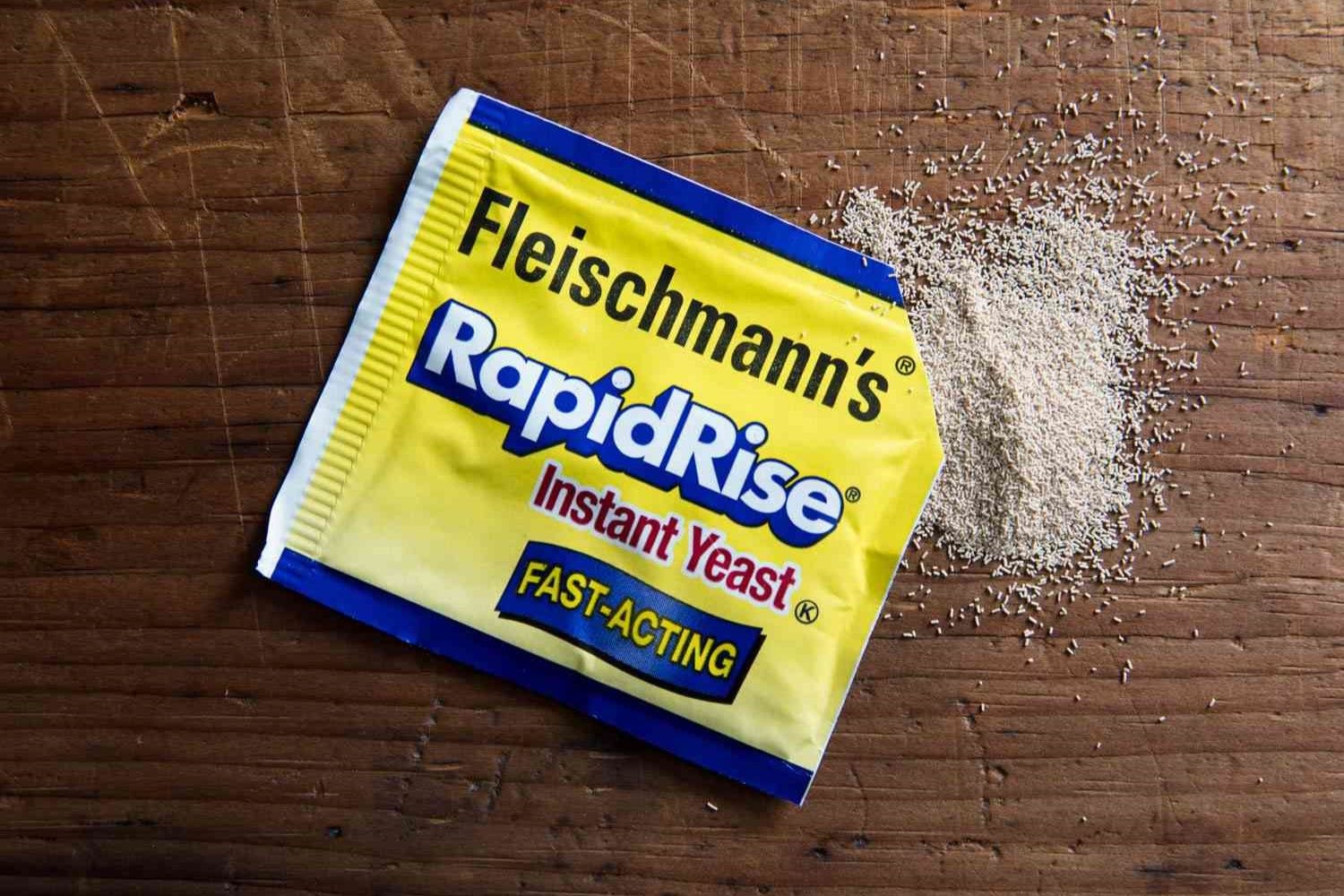Home>Food and Cooking>Is Your Instant Yeast Still Active? Here’s How To Find Out!


Food and Cooking
Is Your Instant Yeast Still Active? Here’s How To Find Out!
Published: January 28, 2024
Discover how to test the activity of your instant yeast and ensure it's still effective for your food and cooking needs. Keep your yeast fresh and active with these simple tips!
(Many of the links in this article redirect to a specific reviewed product. Your purchase of these products through affiliate links helps to generate commission for Noodls.com, at no extra cost. Learn more)
Table of Contents
Introduction
Baking is a delightful and rewarding activity, but it can be disheartening when your bread or pastries don't rise as expected. One of the key factors in the leavening process is yeast, a microorganism that plays a crucial role in fermentation. For many home bakers, instant yeast is a popular choice due to its convenience and reliability. However, it's essential to ensure that your instant yeast is still active before incorporating it into your recipes.
In this article, we will explore the importance of understanding the vitality of instant yeast and how to determine if it is still active. By recognizing the signs of inactive yeast and learning how to perform a simple test, you can confidently proceed with your baking endeavors and achieve delightful, perfectly risen creations.
Whether you're a seasoned baker or just beginning your culinary journey, knowing how to assess the viability of your instant yeast can make a significant difference in the outcome of your baked goods. Let's delve into the world of instant yeast and discover the telltale indicators of its activity, empowering you to bake with assurance and achieve delectable results every time.
Understanding Instant Yeast
Instant yeast, also known as fast-rising or rapid-rise yeast, is a popular choice among bakers for its convenience and efficiency. Unlike active dry yeast, which requires proofing in warm water before use, instant yeast can be added directly to the dry ingredients in a recipe. This time-saving characteristic makes it a preferred option for many home bakers.
Instant yeast is derived from the same strain of yeast as active dry yeast, Saccharomyces cerevisiae, but it is processed in a way that allows for quicker activation. This type of yeast is milled into finer particles and undergoes a specialized drying process, which enables it to rapidly rehydrate and begin fermentation when mixed with other ingredients. As a result, instant yeast significantly reduces the overall rise time of dough compared to active dry yeast.
One of the key advantages of instant yeast is its long shelf life when stored properly. When kept in a cool, dry place and sealed in an airtight container, instant yeast can remain viable for an extended period, making it a reliable pantry staple for spontaneous baking endeavors.
It's important to note that instant yeast is not interchangeable with active dry yeast in all recipes. While they both serve the same fundamental purpose of leavening dough, the difference in particle size and processing means that they may react differently in certain baking applications. Therefore, it's advisable to follow recipes that specifically call for instant yeast to ensure optimal results.
Understanding the nature of instant yeast and its unique characteristics equips bakers with the knowledge needed to harness its full potential. By grasping the distinct properties of instant yeast and its role in the fermentation process, you can make informed decisions when selecting and utilizing this essential ingredient in your baking endeavors.
Signs of Inactive Yeast
Identifying the signs of inactive yeast is crucial for ensuring the success of your baking endeavors. When yeast loses its viability, it becomes unable to perform the essential function of leavening dough through fermentation. Recognizing the indicators of inactive yeast empowers bakers to take proactive measures and maintain the quality of their baked goods. Here are the telltale signs that your instant yeast may be inactive:
-
Lack of Foam: When rehydrated in warm water or combined with sugar, active yeast typically produces a frothy foam on the surface within a few minutes. This effervescent reaction is a clear indication that the yeast is viable and actively fermenting. However, if your instant yeast fails to generate foam or exhibits minimal activity, it may be a sign of diminished viability.
-
Expiration Date: Checking the expiration date on the packaging of your instant yeast is a straightforward yet essential step in determining its viability. Over time, yeast gradually loses its potency, and using expired yeast can lead to lackluster results in your baking. If your yeast has surpassed its expiration date, it's advisable to perform a simple test to assess its activity before incorporating it into your recipes.
-
Unpleasant Odor: Active yeast typically emits a pleasant, slightly sweet aroma, indicative of its vitality. In contrast, inactive yeast may develop an unpleasant or sour smell, signaling that it has lost its efficacy. A discernible change in the scent of your instant yeast could signify that it is no longer suitable for use in baking.
-
Inadequate Rise: When using instant yeast in dough, the expected rise and expansion may be minimal or nonexistent if the yeast is inactive. Properly functioning yeast contributes to the development of airy, well-structured bread and pastries. If your dough fails to rise adequately or exhibits a dense texture, it could be an indication that the yeast is no longer active.
-
Texture and Appearance: Inactive yeast may present a clumped or granular texture, deviating from the fine, powdery consistency characteristic of viable instant yeast. Additionally, the color of inactive yeast may appear dull or off-white, contrasting with the vibrant, pale hue of fresh, active yeast.
By being attentive to these signs, you can promptly assess the condition of your instant yeast and make informed decisions regarding its suitability for use in your baking projects. Understanding the indicators of inactive yeast enables you to uphold the quality of your baked creations and maintain the integrity of your recipes.
Testing the Yeast
When uncertainty arises regarding the viability of your instant yeast, conducting a simple test can provide clarity and assurance before proceeding with your baking endeavors. The following method offers a reliable way to evaluate the activity of your instant yeast, allowing you to make informed decisions and achieve optimal results in your culinary creations.
Yeast Activation Test
Ingredients:
- 1/2 cup of lukewarm water (approximately 110°F to 115°F)
- 1 teaspoon of granulated sugar
- 2 1/4 teaspoons of instant yeast
Procedure:
-
Begin by preparing the lukewarm water, ensuring that it is within the temperature range of 110°F to 115°F. The ideal temperature facilitates yeast activation without causing damage to the microorganisms.
-
In a clean, small bowl, combine the lukewarm water and granulated sugar, stirring gently to dissolve the sugar. The sugar serves as a nourishing source for the yeast and aids in stimulating its activity.
-
Once the sugar is fully dissolved, sprinkle the instant yeast evenly over the surface of the water and sugar mixture. Avoid stirring at this stage, allowing the yeast to hydrate undisturbed.
-
Allow the yeast to rest in the water and sugar solution for approximately 5 to 10 minutes. During this time, the yeast should begin to rehydrate and activate, manifesting as a visible foam or froth on the surface of the liquid.
-
After the designated resting period, observe the surface of the water for signs of yeast activity. Active yeast will produce a noticeable layer of foam, indicating that it is viable and prepared for use in your recipes.
Interpretation:
-
Presence of Foam: If the surface of the water exhibits a substantial layer of foam with a light, airy texture, this is a positive indication of active yeast. The robust foam signifies that the yeast has rehydrated and is ready to be incorporated into your dough or batter.
-
Minimal or Absent Foam: In the event that the yeast fails to generate a significant foam layer or exhibits minimal activity, this may suggest that the yeast is no longer viable and should be replaced with fresh instant yeast for optimal results in your baking endeavors.
By performing this straightforward yet insightful test, you can confidently ascertain the vitality of your instant yeast, ensuring that it is primed to facilitate the leavening process and contribute to the delightful texture and flavor of your baked goods. Incorporating this test into your baking routine empowers you to maintain the quality and integrity of your recipes, enabling you to craft exceptional bread, pastries, and other culinary delights with the assurance of active, reliable yeast.
Conclusion
In the realm of baking, the vitality of instant yeast holds significant sway over the outcome of your culinary creations. By recognizing the importance of understanding and assessing the activity of instant yeast, you can elevate your baking endeavors to new heights of success and satisfaction. Through the exploration of the signs of inactive yeast and the implementation of a straightforward yeast activation test, you can confidently navigate the realm of instant yeast and ensure that your baked goods rise to perfection.
Understanding the signs of inactive yeast empowers you to preemptively address potential issues before they compromise the quality of your recipes. Whether it's observing the lack of foam during yeast rehydration, checking the expiration date, detecting an unpleasant odor, noting inadequate rise, or discerning changes in texture and appearance, these indicators serve as valuable guides in evaluating the viability of your instant yeast. By remaining attuned to these signs, you can make informed decisions regarding the suitability of your yeast for use in your baking projects, safeguarding the excellence of your culinary creations.
Moreover, the yeast activation test provides a practical and reliable method for confirming the activity of your instant yeast. By simply combining lukewarm water, sugar, and instant yeast, and observing the resulting foam, you can gain valuable insights into the vitality of your yeast. This straightforward test offers a tangible way to gauge the readiness of your yeast for leavening dough, ensuring that it possesses the vigor needed to contribute to the airy, delectable texture of your bread, pastries, and other baked delights.
Incorporating the yeast activation test into your baking routine not only instills confidence in the viability of your instant yeast but also cultivates a deeper connection to the artistry of baking. It serves as a ritual of assurance, allowing you to embark on your culinary endeavors with the peace of mind that your yeast is poised to fulfill its essential role in the fermentation process. With this knowledge and practical approach, you can embark on your baking ventures with renewed confidence, knowing that your instant yeast is ready to collaborate in the creation of exceptional, perfectly risen delicacies.
In conclusion, by embracing the nuances of instant yeast and equipping yourself with the tools to assess its vitality, you can embark on a journey of baking mastery, marked by consistently delightful results and the fulfillment of your culinary aspirations. With the ability to recognize the signs of inactive yeast and the confidence instilled by the yeast activation test, you are poised to create an array of impeccable bread, pastries, and baked goods, each bearing the hallmark of well-risen perfection—a testament to your expertise and dedication in the art of baking.













